Dating Factory ID’s
A Cigar History Museum EXCLUSIVE
by Tony Hyman
© Tony Hyman
Minor changes for clarity: May, 2011

Dating Factory ID’s
A Cigar History Museum EXCLUSIVE
by Tony Hyman
© Tony Hyman
Minor changes for clarity: May, 2011
Federal tax laws required all cigar boxes made in the U.S. to have:
[1] tax stamps (1863-1959),
[2] factory I.D.’s (1866-1960’s),
[3] caution notices (1868-1959)
[4] tax class notices (1917-1959)
Cigar makers were required to identify themselves on cigar boxes between 1866 and 1959, and in modified form for a few decades thereafter. ID’s were an important element in the war on tax evaders because they told a tax inspector three vital facts: who made the cigars, where the factory was located, and how many cigars were in the box. Factory IDs are the only printed matter on a cigar box you can count on to be true.
Tin and Glass ID’s
Tin was authorized for cigar boxes in 1870. From the beginning ID’s were required to be permanently stamped into the tin. The example [left] shows an ID in which the factory number is being changed because the company who owned the brand switched cigar makers. Fortunately for the guy who had to hand-make the change on already existing cans, both the old and new factory were in PA’s huge 9th Tax district, specialists in custom brands.
Glass has always been legal packing for cigars, but ID’s were required to be molded into the glass.
ID’s on glass and tin do not appear to be of dating use.
There’s more about using government regulations to date cigar boxes.
Type VI: novelty
A minimum type size was specified but a great deal of flexibility in ID form was permitted. As a result, numerous variants of ID’s exist, some quite elaborate like the combination trade mark and ID eagle used by a mid 1880’s California cigar factory.
As a cost-cutting move (saving one die stamping at the box maker) a few 19th century factories put their ID in a single line form on the top of the box under the top brand. Not illustrated.
A handful of cigar makers, like Florida’s Eduardo H. Gato, chose huge distinctive ID’s covering the bottom of the box as another form of trade mark. At least one company continued giant ID’s into the 50’s.
Novelty ID’s are in the minority, and are of little use in dating.
Type IV: three line ID 1883-1910
By the mid 1880’s the three line ID had taken over.
It is found on 95% of wooden cigar boxes for the next 35 years (the Golden Age of Cigars).
Type V: ID w/notice 1910 - 1959
After 1910, the 3-line ID was still used, but also printed on the bottom was the Caution Notice and, in the 1920’s the Tax Paid notice. The ID was frequently printed as a single line. The law required the Caution Notice to repeat the factory number and tax district. Printed, rather than incised, ID’s became acceptable as cardboard boxes became commonplace.
Type II: round with name 1872-1880
After 1872 boxes could be incised with a round ID the size of a quarter containing the maker’s name in the top arc, tax district and state in the bottom arc and number of cigars in the center. This Type II ID (far left) is used throughout the 1870’s, making it easy to identify boxes from that decade.
Type III: round with factory number
1880-1883+
In 1880 the maker’s name was replaced by the federally assigned factory number in the top arc. The law requiring this style was not long lived, permitting type IV three line ID’s in 1883. Round type III ID’s can not be relied upon to date a box as they remained legal after 1883, just not required, and a few companies used them for decades.
In general, when you see one of these hot branded ID’s, think “1860’s style” box, though the style actually overlaps to the mid 1870’s.
The combination of hot brand and caution notice dates a box 1868-1872±.
You may find a late 1870’s box with a branded I.D. like the 1878 J.T.LEWIS. It was legal but not common. Most boxmakers and cigar factories abandoned hot branding the minute it was legal to to so.
Six types of I.D. can help date a box.
1866-1872+
The feds called this info the “factory brand” because it was required to be hot branded with iron dies like the crates and barrels of an earlier age. Collectors and historians call them “ID’s” to avoid confusion with trademark brand names.
Neither size nor placement of ID’s was regulated until 1872. Usually found on the bottom of a box, ID’s are also on fronts, backs and sides.
Hot branding was slow and dangerous in the hands of amateurs. After numerous fires and injuries, the specifications for IDs were changed as part of the Revenue Act of 1872.

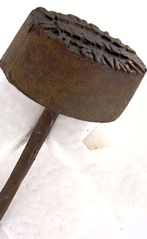
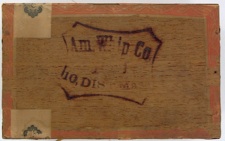
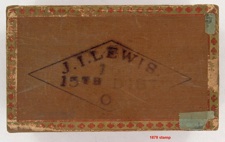

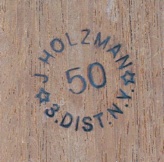
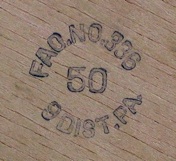
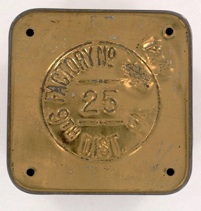

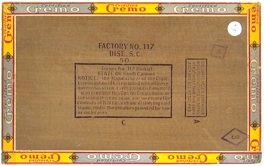

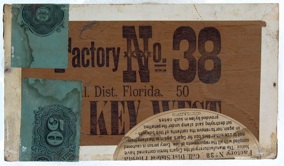
Only a few thousand cigar factories existed during the hot brand era, so boxes from this period are scarce. Branding irons are even more rare.
Hot brand era boxes are often quite plain with no inner, making an 1866 box like this picturing Gen. Grant between the Civil War and his Presidency particularly desirable.
Box made in Binghampton, one of NY’s many 21st Tax District cigar towns.